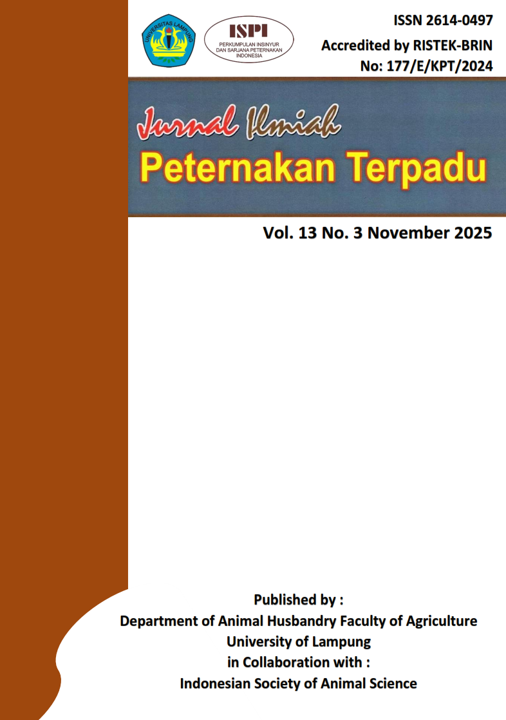Improvement Performans of Pregnant Cross Awassi Sheep using Silage Total Mixed Ration (Tmr) Feed Technology
DOI:
https://doi.org/10.23960/jipt.v13i3.p1003-1012 Abstract View: 1
Abstract View: 1
Keywords:
Domba Awassi, Perfoma, Total Mixed Ratio, SilaseAbstract
The effect of feeding Pakchong and Indigofera-based silage Total Mixed Ration (TMR) on the production performance of pregnant Cross Awassi sheep was evaluated using 6 pregnant sheep, which were randomly divided into two treatment groups. Three sheep were allocated to the control group (P0) which was fed a conventional diet based on fresh forage and standard concentrate, while the other three were placed in the treatment group (P1) which was fed fermented silage TMR for 14 days. Each sheep received feed at 3.5% of body weight per day, with access to drinking water ad libitum. During the 30-day study, feed consumption, daily body weight gain (ADG), feed conversion (FCR), and cempe birth weight were analyzed. The results showed that feed consumption in the treatment group (10.62±1.192 kg/head/day) was higher than the control group (9.84±1.056 kg/head/day). ADG of the treatment group (1.2±0.10 kg) was higher than the control group (0.85±0.12 kg). Birth weight of cempe in the treatment group (4.08±0.769 kg) was higher than the control group (3.72±0.685 kg) with a statistically significant difference (P < 0.05). The FCR value was lower in the treatment group (14.93) than the control group (20.24), indicating better feed efficiency. Therefore, feeding Pakchong and Indigofera-based TMR silage can improve feed efficiency, productivity, and cempe birth weight in pregnant Cross Awassi Sheep.
Downloads
References
Alves, D. D., Silva, T. C., Silva, A. M. A., et al. (2020). Use of silage in ruminant nutrition and its effects on intake and digestibility. Acta Scientiarum. Animal Sciences, 42, e46045. https://doi.org/10.4025/actascianimsci.v42i1.46045
Basu, S., Adhikari, R., Kundu, S. S., & Das, M. M. (2019). Total mixed ration feeding for dairy animals using locally available resources: An economic analysis. Indian Journal of Animal Nutrition, 36(1), 90–94. https://doi.org/10.5958/2231-6744.2019.00015.1
Gootwine, E. (2011). Mini review: Breeding Awassi and improved Awassi sheep for diverse management conditions. Tropical Animal Health and Production, 43(7), 1289–1296. https://doi.org/10.1007/s11250-011-9851-x
Haddad, S. G., & Husein, M. Q. (2004). Effect of allowing nursing to continue during mid to late gestation on the performance of Awassi ewes and lambs. Small Ruminant Research, 53(1–2), 41–45. https://doi.org/10.1016/j.smallrumres.2003.08.012
Kenyon, P. R., Maloney, S. K., & Blache, D. (2014). Review: Nutrition–lamb birth weight and survival. New Zealand Veterinary Journal, 62(4), 171–177. https://doi.org/10.1080/00480169.2014.902347
Merryafinola, Y. D., Yuliarti, E., & Yunilas, Y. (2022). Nutrient content and quality of Indigofera zollingeriana as forage for ruminants. Jurnal Peternakan Indonesia (Indonesian Journal of Animal Science), 24(1), 34–42. https://doi.org/10.25077/jpi.24.1.34-42.2022
NRC (National Research Council). (2007). Nutrient Requirements of Small Ruminants: Sheep, Goats, Cervids, and New World Camelids. National Academies Press. https://doi.org/10.17226/11654
Schingoethe, D. J. (2017). Feeding total mixed rations (TMR) to dairy cows. In Feeding Systems and Feed Evaluation Models (pp. 151–164). CABI. https://doi.org/10.1079/9781780640129.0151
Van Soest, P. J. (1994). Nutritional Ecology of the Ruminant (2nd ed.). Cornell University Press.
González-Reyna, A., & Vázquez-Armijo, J. F. (2025). Sheep Meat Production Systems: The Use of Sugar Cane Molasses and Beef Fat in TMR. IntechOpen. https://www.intechopen.com/chapters/89788
Bokharaeian, M., Toghdory, A., & Ghoorchi, T. (2024). Effects of curcumin nano-micelles on performance and thermal stress resilience in lambs fed TMR. Journal of Thermal Biology. https://doi.org/10.1016/j.jtherbio.2024.103818
Alshdaifat, M. M., Serbester, U., Obeidat, B. S., & Gorgulu, M. (2023). Fish oil supplementation during gestation: Effects on Awassi ewes and lambs. Animals, 13(24), 3888. https://www.mdpi.com/2076-2615/13/24/3888
Dalaf, A. (2024). Effect of age of Awassi ewes crossed with Naimi rams on lamb growth characteristics. Jurnal Veteriner, Universitas Airlangga. https://e-journal.unair.ac.id/OVZ/article/view/64389
Hassan, S. A., & Almaamory, Y. A. (2019). Effect of enzyme treatments for some roughages on average gain performance, feed conversion ratio and nutrient digestibility of Awassi lambs. Plant Archives, 19(1), 993–1002. Link PDF
Yusuf, H. A., Rehemujiang, H., Ma, T., Piao, M., Huo, R., & Tu, Y. (2022). Fermented TMR with cottonseed meal or rapeseed meal improved growth performance and meat quality of Hu lambs. Fermentation, 8(11), 576. https://www.mdpi.com/2311-5637/8/11/576
Alharthi, A. S., Al-Baadani, H. H., & Al-Badwi, M. A. (2021). Effects of sunflower hulls on productive performance, digestibility indices and rumen morphology of growing Awassi lambs fed with total mixed rations. Veterinary Sciences, 8(9), 174. https://www.mdpi.com/2306-7381/8/9/174
Almahdawi, M. K. K., & Altalib, A. A. T. (2020). Impact of using dried bread residue as substitution of energy source for cereals on milk production and its ingredients of Awassi ewes. Eurasian Journal of Biosciences, 14, 3985–3990. ResearchGate PDF
Assan, N., Bhakat, C., & Chisoro, P. (2025). The Role of Feed Resources in Optimizing Reproductive Efficiency in Goats and Sheep. Multidisciplinary Global Education, 2(39), 1–10. Download PDF
Downloads
Published
How to Cite
Issue
Section
License
Copyright (c) 2025 Intan Nur Aisah, Dewi Ratih Ayu Daning, Iman Aji Wijoyo

This work is licensed under a Creative Commons Attribution 4.0 International License.

Jurnal Ilmiah Peternakan Terpadu(JIPT) is licensed under a Creative Commons Attribution 4.0 International License.
Authors who publish with this journal agree to the following terms:
- Authors retain copyright and grant the journal right of first publication with the work simultaneously licensed under a Creative Commons Attribution License that allows others to share the work with an acknowledgement of the work's authorship and initial publication in this journal.
- Authors are able to enter into separate, additional contractual arrangements for the non-exclusive distribution of the journal's published version of the work (e.g., post it to an institutional repository or publish it in a book), with an acknowledgement of its initial publication in this journal.
- Authors are permitted and encouraged to post their work online (e.g., in institutional repositories or on their website) prior to and during the submission process, as it can lead to productive exchanges, as well as earlier and greater citation of published work (See The Effect of Open Access).





















